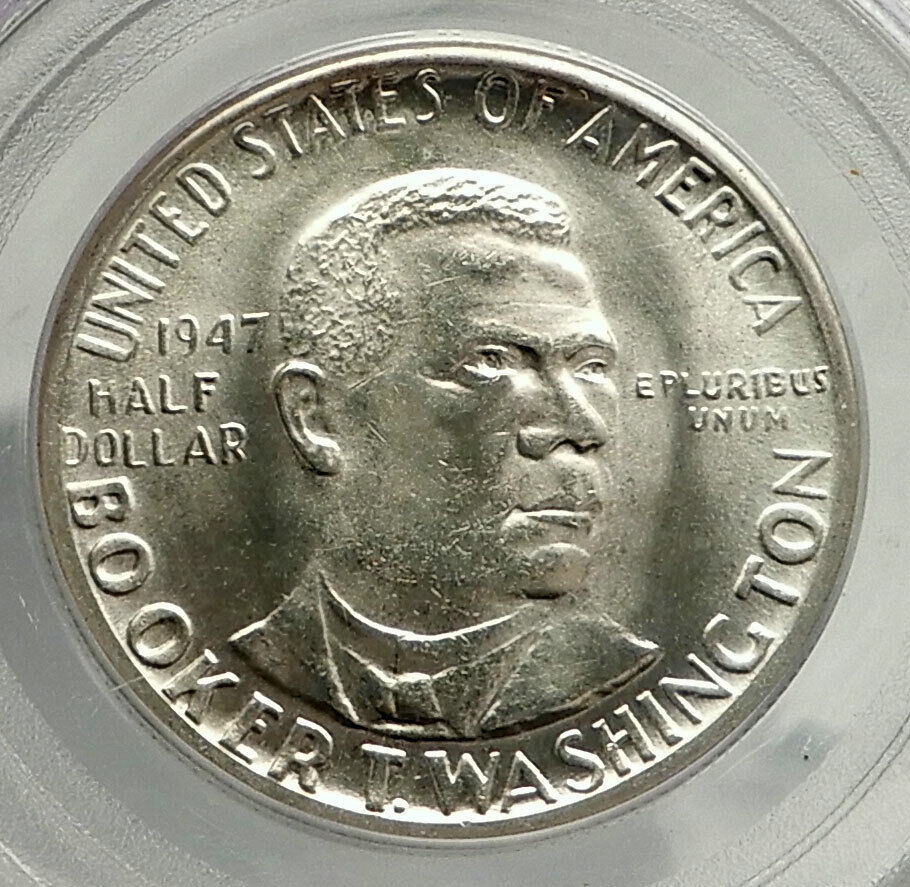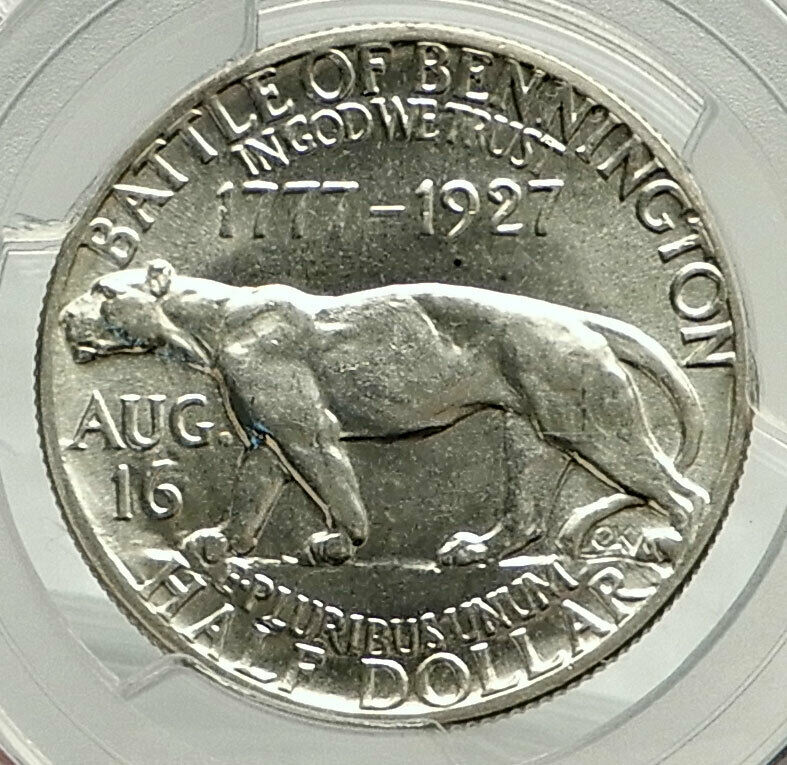|
United States of America – Commemorative Half Dollar
300th Anniversary of the Settlement of Connecticut
1935 Silver 50 Cents (Half Dollar) 30.6mm (12.50 grams) 0.900 Silver (0.3617 oz. ASW) Philadelphia mint
Reference: KM# 169 | Engraver: Henry G. Kreis
Certification: PCGS MS 64 9299.64/36769597 | Mintage: 25,018
IN GOD WE TRUST LIBERTY THE CHARTER OAK CONNECTICUT 1635-1935, Charter Oak.
UNITED STATES OF AMERICA E PLURIBUS UNUM HALF DOLLAR, Easgle with closed wings standing left.
You are bidding on the exact item pictured, provided with a Certificate of Authenticity and Lifetime Guarantee of Authenticity.
.svg/250px-Connecticut_in_United_States_(zoom).svg.png) Connecticut is the southernmost state in the New England region of the United States. As of the 2010 Census, it has the highest per-capita income, Human Development Index (0.962), and median household income in the United States. It is bordered by Rhode Island to the east, Massachusetts to the north, New York to the west, and Long Island Sound to the south. Its capital is Hartford and its most populous city is Bridgeport. It is part of New England, although portions of it are often grouped with New York and New Jersey as the Tri-state area. The state is named for the Connecticut River which approximately bisects the state. The word “Connecticut” is derived from various anglicized spellings of an Algonquian word for “long tidal river”. Connecticut is the southernmost state in the New England region of the United States. As of the 2010 Census, it has the highest per-capita income, Human Development Index (0.962), and median household income in the United States. It is bordered by Rhode Island to the east, Massachusetts to the north, New York to the west, and Long Island Sound to the south. Its capital is Hartford and its most populous city is Bridgeport. It is part of New England, although portions of it are often grouped with New York and New Jersey as the Tri-state area. The state is named for the Connecticut River which approximately bisects the state. The word “Connecticut” is derived from various anglicized spellings of an Algonquian word for “long tidal river”.
Connecticut’s first European settlers were Dutchmen who established a small, short-lived settlement called Fort Hoop in Hartford at the confluence of the Park and Connecticut Rivers. Half of Connecticut was initially part of the Dutch colony New Netherland, which included much of the land between the Connecticut and Delaware Rivers, although the first major settlements were established in the 1630s by the English. Thomas Hooker led a band of followers from the Massachusetts Bay Colony and founded the Connecticut Colony; other settlers from Massachusetts founded the Saybrook Colony and the New Haven Colony. The Connecticut and New Haven colonies established documents of Fundamental Orders, considered the first constitutions in America. In 1662, the three colonies were merged under a royal charter, making Connecticut a crown colony. This was one of the Thirteen Colonies which rejected British rule in the American Revolution.
Connecticut is the third smallest state by area, the 29th most populous, and the fourth most densely populated of the 50 states. It is known as the “Constitution State”, the “Nutmeg State”, the “Provisions State”, and the “Land of Steady Habits”. It was influential in the development of the federal government of the United States.
The Connecticut River, Thames River, and ports along Long Island Sound have given Connecticut a strong maritime tradition which continues today. The state also has a long history of hosting the financial services industry, including insurance companies in Hartford and hedge funds in Fairfield County.
 The Charter Oak was an unusually large white oak tree growing on Wyllys Hyll in Hartford, Connecticut in the United States, from around the 12th or 13th century until it fell during a storm in 1856. According to tradition, Connecticut’s Royal Charter of 1662 was hidden within the hollow of the tree to thwart its confiscation by the English governor-general. The oak became a symbol of American independence and is commemorated on the Connecticut State Quarter. In 1935, for Connecticut’s tercentennial, it was also depicted on both a commemorative half dollar and a postage stamp. The Charter Oak was an unusually large white oak tree growing on Wyllys Hyll in Hartford, Connecticut in the United States, from around the 12th or 13th century until it fell during a storm in 1856. According to tradition, Connecticut’s Royal Charter of 1662 was hidden within the hollow of the tree to thwart its confiscation by the English governor-general. The oak became a symbol of American independence and is commemorated on the Connecticut State Quarter. In 1935, for Connecticut’s tercentennial, it was also depicted on both a commemorative half dollar and a postage stamp.
Early history
Dutch explorer Adrian Block described a tree at the future site of Hartford in his log in 1614 which is understood to be this one. In the 1630s, a delegation of local Native Americans is said to have approached Samuel Wyllys, the early settler who owned and cleared much of the land around it, encouraging its preservation and describing it as planted ceremonially, for the sake of peace, when their tribe first settled in the area.
It has been the guide of our ancestors for centuries as to the time of planting our corn; when the leaves are the size of a mouse’s ears, then is the time to put the seed into the ground.
Charter Oak incident
The name “Charter Oak” stems from the local legend in which a cavity within the tree was used in late 1687 as a hiding place for the Charter of 1662.
This much regarding the charter is history:
- King Charles II granted the Connecticut Colony an unusual degree of autonomy in 1662.
- His successor James II consolidated several colonies into the Dominion of New England in 1686, in part to take firmer control of them.
- He appointed Sir Edmund Andros as governor-general over it, who stated that his appointment had invalidated the charters of the various constituent colonies. He went to each colony to collect their charters, presumably seeing symbolic value in physically reclaiming the documents.
- Andros arrived in Hartford late in October 1687, where his mission was at least as unwelcome as it had been in the other colonies.
According to the dominant tradition, Andros demanded the document and it was produced, but the lights were suddenly doused during ensuing discussion. The parchment was spirited out a window and thence to the Oak by Captain Joseph Wadsworth, ancestor of Elijah Wadsworth.
Two documents raise less dramatic possibilities, one contemporaneous and one from early in the next century, by suggesting that a parchment copy had been made of the true charter as early as June, in anticipation of Andros’s arrival:
- It has been suggested that the copy was surreptitiously substituted for the original and the original secreted in the oak lest Andros find it in any search of buildings, and that Andros left believing that he had succeeded.
- Logically, such a copy (whether hidden in the oak or not) might instead have been the one kept, for the value it might have in propaganda, for morale, or in petitioning for its reinstatement.
The Museum of Connecticut History (a subdivision of the Connecticut State Library) credits the idea that Andros never got the original charter, and displays a parchment that it regards as the original. (The Connecticut Historical Society is said[by whom?] to possess a “fragment” of it.)
Andros was overthrown in Boston two years later in the 1689 Boston revolt. The Dominion of New England was then dissolved.
|









.svg/250px-Connecticut_in_United_States_(zoom).svg.png) Connecticut is the southernmost state in the New England region of the United States. As of the 2010 Census, it has the highest per-capita income, Human Development Index (0.962), and median household income in the United States. It is bordered by Rhode Island to the east, Massachusetts to the north, New York to the west, and Long Island Sound to the south. Its capital is Hartford and its most populous city is Bridgeport. It is part of New England, although portions of it are often grouped with New York and New Jersey as the Tri-state area. The state is named for the Connecticut River which approximately bisects the state. The word “Connecticut” is derived from various anglicized spellings of an Algonquian word for “long tidal river”.
Connecticut is the southernmost state in the New England region of the United States. As of the 2010 Census, it has the highest per-capita income, Human Development Index (0.962), and median household income in the United States. It is bordered by Rhode Island to the east, Massachusetts to the north, New York to the west, and Long Island Sound to the south. Its capital is Hartford and its most populous city is Bridgeport. It is part of New England, although portions of it are often grouped with New York and New Jersey as the Tri-state area. The state is named for the Connecticut River which approximately bisects the state. The word “Connecticut” is derived from various anglicized spellings of an Algonquian word for “long tidal river”.  The Charter Oak was an unusually large white oak tree growing on Wyllys Hyll in Hartford, Connecticut in the United States, from around the 12th or 13th century until it fell during a storm in 1856. According to tradition, Connecticut’s Royal Charter of 1662 was hidden within the hollow of the tree to thwart its confiscation by the English governor-general. The oak became a symbol of American independence and is commemorated on the Connecticut State Quarter. In 1935, for Connecticut’s tercentennial, it was also depicted on both a commemorative half dollar and a postage stamp.
The Charter Oak was an unusually large white oak tree growing on Wyllys Hyll in Hartford, Connecticut in the United States, from around the 12th or 13th century until it fell during a storm in 1856. According to tradition, Connecticut’s Royal Charter of 1662 was hidden within the hollow of the tree to thwart its confiscation by the English governor-general. The oak became a symbol of American independence and is commemorated on the Connecticut State Quarter. In 1935, for Connecticut’s tercentennial, it was also depicted on both a commemorative half dollar and a postage stamp. 




